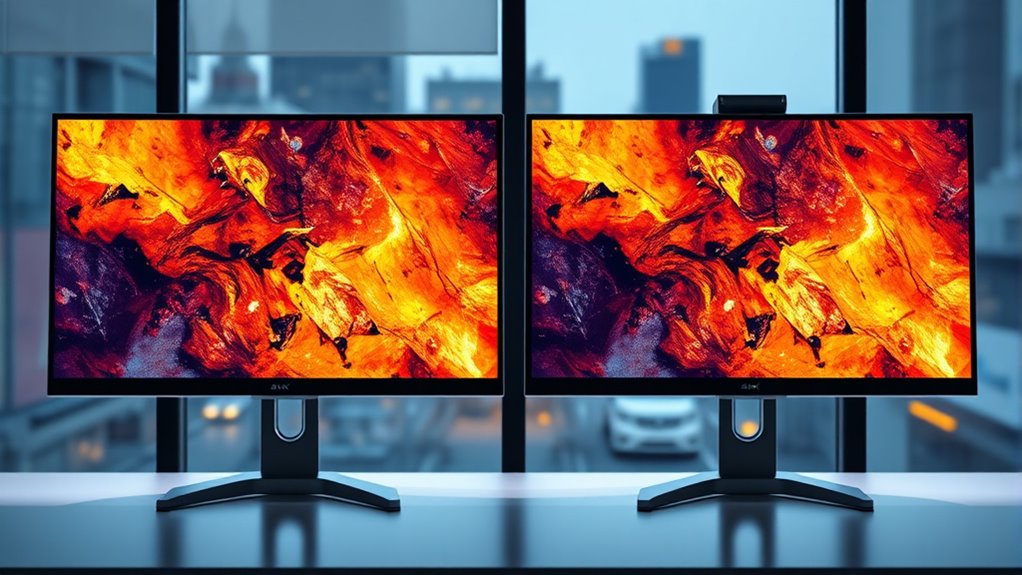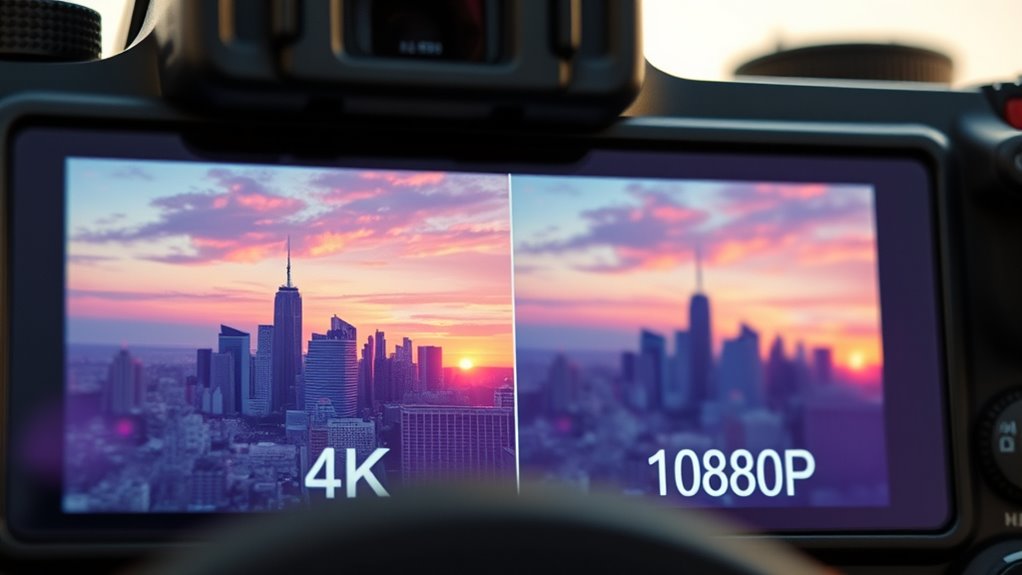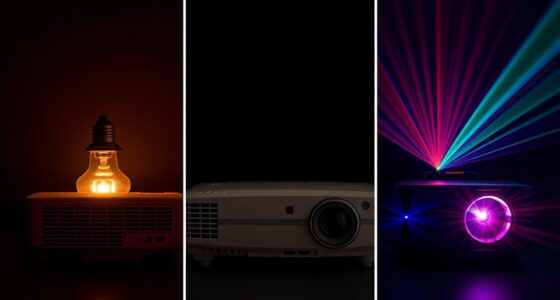When comparing 4K and 1080P, remember that resolution isn’t the only factor affecting picture quality. While 4K offers sharper details, a higher pixel density, better display technology, and proper viewing distance matter just as much. Many myths suggest 4K automatically means better images, but other elements like refresh rates and screen size play big roles. Want to know which choice fits your needs? Keep exploring to discover the full picture.
Key Takeaways
- Resolution alone doesn’t determine image quality; factors like pixel density, display technology, and color depth are crucial.
- 4K offers sharper details but requires a larger screen or closer viewing distance to notice the difference from 1080P.
- Higher refresh rates and better panel quality can improve viewing experience more than resolution alone.
- Screen size and viewing distance significantly impact perceived sharpness, regardless of resolution.
- The best display choice depends on use case, environment, and overall display quality, not just resolution.
Understanding Resolution: What Does 4K and 1080P Really Mean?
Understanding resolution is key to knowing the difference between 4K and 1080P. Resolution refers to the number of pixels that make up your screen, affecting pixel density—the concentration of pixels per inch. Higher pixel density results in sharper images and finer detail. 4K resolution offers about four times the pixels of 1080P, providing greater clarity, especially on larger screens. Both formats typically share the same aspect ratio, usually 16:9, which determines the width-to-height ratio of your display. This aspect ratio influences how content appears without distortion. When comparing resolutions, focus on pixel density and aspect ratio, as these factors directly impact picture quality and how well images fit your screen. Understanding these basics helps you make smarter choices about your viewing experience.
Common Myths About 4K and 1080P Debunked

Many people believe that 4K always means better quality than 1080P, but that’s not entirely true. While 4K offers higher resolution, other factors like pixel density and color depth considerably influence picture quality. A common myth is that resolution alone determines clarity, but a display with high pixel density and rich color depth can outperform a lower-resolution screen. For example:
| Aspect | 4K Benefits | 1080P Benefits |
|---|---|---|
| Pixel Density | Higher, sharper details | Lower, less detailed |
| Color Depth | Often greater, richer colors | Usually standard, less vibrant |
| Image Clarity | Depends on screen size and quality | Can appear sharp on smaller sizes |
| Viewing Experience | Enhanced with better tech | Still good for smaller screens |
Understanding these myths helps you choose displays that truly match your viewing needs beyond just resolution. Additionally, display technology plays a crucial role in overall visual quality, emphasizing that resolution is just one part of the bigger picture.
Key Factors That Impact Your Viewing Experience

While resolution plays a significant role in picture quality, several other factors can greatly influence your overall viewing experience. First, refresh rates matter; higher rates like 120Hz make motion smoother, especially during fast-paced scenes. Second, screen size impacts how immersive your viewing feels—larger screens can enhance detail but require higher resolution for clarity. Third, viewing distance and the quality of your display’s panel affect how sharp images appear and how comfortable your eyes are over time. Even with 4K or 1080p, these elements determine whether your experience feels fluid, crisp, and engaging. Paying attention to display quality and other factors ensures you get the most out of your viewing setup.
Choosing the Right Display for Your Needs

Choosing the right display depends on how you plan to use it and your viewing environment. Your screen size plays a vital role—larger screens are ideal for immersive viewing, but only if your viewing distance is appropriate. If you sit close to a big screen, higher resolutions like 4K can provide sharper images and more detail, preventing pixelation. Conversely, smaller screens or distant viewing areas may not benefit as much from 4K, making 1080p sufficient. Consider how you’ll use the display—gaming, streaming, or professional work—and match the resolution to your space. Also, make certain your viewing distance aligns with the screen size; sitting too close to a large display can reveal pixel structure, while sitting farther away may mask the resolution benefits.
Frequently Asked Questions
How Does Screen Size Influence Perceived Resolution Quality?
As screen size increases, perceived resolution quality depends on pixel density and your viewing distance. Larger screens with higher pixel density look sharper, especially when you sit close enough. If you sit farther away, differences between 1080P and 4K become less noticeable, regardless of size. So, for big screens, opt for higher pixel density and maintain a suitable viewing distance to enjoy crisp, clear images.
What Role Does Content Type Play in Resolution Importance?
Imagine the joy of perfect content compatibility, where your resolution choice truly shines. The type of content you enjoy—whether movies, gaming, or streaming—directly influences how important resolution is for visual clarity. For fast-paced action, higher resolutions like 4K enhance detail, while casual viewing may not require it. Tailoring your resolution to your content ensures a richer, more immersive experience, making every moment feel just right.
Are Higher Resolutions Always Better for Gaming Performance?
Higher resolutions aren’t always better for gaming performance because resolution scaling can impact your frame rates. While increased resolution improves visual clarity, it also demands more from your GPU, potentially causing lag or stuttering. If your hardware struggles with higher resolutions, you might prefer lower settings for smoother gameplay. Ultimately, balance resolution and performance to enjoy sharp visuals without sacrificing game responsiveness.
How Do Bandwidth and Internet Speed Affect 4K Streaming?
Your bandwidth and internet speed directly impact 4K streaming quality, causing potential buffering or compression artifacts if they’re insufficient. Slow speeds may force the stream to lower quality or introduce compression artifacts, reducing clarity. To get the best experience, make certain your connection is fast enough for 4K, and consider display calibration to optimize picture quality. Upgrading your plan and optimizing your network can markedly improve streaming smoothness and visual fidelity.
Can Resolution Improve Battery Life on Portable Devices?
You might think higher resolution improves battery life, but in reality, it often strains your device’s hardware limitations and can drain the battery faster. To optimize battery life, focus on battery optimization settings and lower the display resolution if possible. Coincidentally, reducing resolution may not always boost longevity, but it lessens the workload on your hardware, helping your portable device last longer during heavy use.
Conclusion
Now that you know the truth about 4K and 1080p, don’t settle for less—your eyes deserve the clearest, sharpest experience possible! Whether you’re binge-watching, gaming, or working, choosing the right resolution can transform your entire viewing world. Don’t let myths fool you—your perfect display is out there waiting. Upgrade now and see details so stunning, they’ll blow your mind and make everything else look outdated overnight!








